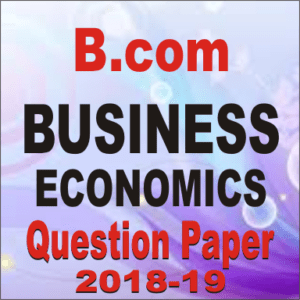Bcom Business Economics Question Paper 2018-19
Bcom Business Economics Question Paper 2018-19 :- Dear student in this article we are describe to you bcom business Regulatory Economics question paper of chaudhary charan singh university meerut. and but if all university’s student can get help from here. how type exam is asking in exam.

B.Com. 1 Year Examination, 2018 (unified Syllabus)
COMMERCE- v ( Business Economics )
Time:3hrs.] (C-105) [M.M.: 100
Note: इस – पत्र को पाच खण्डो – अ , ब , स , द , एवं इ में विभाजित किया गया है | खण्ड – अ ( लघु उतरीय प्रश्न है , जिसके दस भाग है | ये सभी दस भाग अनिबार्य है | खण्ड – ब , स , द , एवं इ ( विस्तृत उतरीय प्रश्न ) प्रत्येक में दो प्रश्न है | प्रत्येक खण्ड से एक प्रश्न कीजिए | विस्तृत उतर अपेक्षित है |
This is paper is divided into five Sections – A, B, C, D, & E Section – A ( Short Answer Questions ) contains one question of ten parts requiring short answer . all these ten parts one compulsory . Sections –B, C, D, & E (Descriptive Answer questions) each contains two questions. Attempt one question from each Section. Answer must be descriptive.
इस प्रश्न में एक प्रश्न के दस भागो के लघु अपेक्षित है | प्रत्येक भाग 4 अंक का है |
This Section contains one question of ten parts requiring short answer. Each part carries 4 marks
Section – A (खण्ड – अ)
(Short Answer Questions) (लघु उत्तरीय प्रश्न)
This Sections one question of ten parts requiring short answers. Each carries 4 marks.
इस खण्ड में एक प्रश्न के दस भागों के लघु उत्तर अपेक्षित है | प्रत्येक भाग 4 अंको का है |
1, (a) Explain the scope of Business Economics.
व्यावसायिक अर्थशास्त्र का क्षेत्र बतलाइए |
(b) Demand of a commodity decreases from 400 units as a result of 20% increase in its price. Calculate price elasticity of demand.
एक वास्तु के मूल्य में 20% वृध्दि के परिणामस्वरूप उसकी माँग 400 इकाइयों से घटकर 300 इकाइयाँ रह जाती है | माँग की मूल्य लोच ज्ञात कीजिए |
(c) Distinguish between perfectly elastic demand and perfectly inelastic demand.
पूर्णतय लोचदार माँग और पूर्णतया बेलोचदार माँग में अन्तर कीजिए |
(d) What is Cobb-Douglas production function?
काँब-डगलस उत्पादन फलन क्या है?
(e) What is optimum factor combination? How is it determined?
अनुकूलतम साधन संयोग क्या है? यह कैसे निर्धारित किया जाता है?
(f) Explain the opportunity cost concept.
अवसर लागत विचारधारा को समझाइए |
(g) “Perfect competition is a myth.” How far do you agree?
“पूर्ण प्रतियोगिता एक भ्रम है|” आप कहाँ तक सहमत है?
(h) Distinguish between quasi-rent and interest.
आभास लगान और ब्याज में अंतर बताइए |
(i) Distinguish between nominal wages and real wages.
नकद मजदूरी और वास्तविक मजदूरी में अन्तर बताइए |
(j) “Profit is the reward for risk taking and uncertainty bearing.” Explain.
“लाभ जोखिम उठाने तथा अनिश्चितता सहन करने का पुरस्कार है |” समझाइए |
Section-B (खण्ड-ब)
“Business Economics is study of the behavior of firms in theory and practice.” Discuss and give the characteristics of business Economics.
“व्यावसायिक अर्थशास्त्र सिधांत और व्यवहार दोनों में फर्मो के आचरण का अध्ययन है |” स्पष्ट कीजिए और व्यावसायिक अर्थशास्त्र की विशेषताएँ बताइए |
Or/अथवा
3, “If demand is elastic comparatively lower price will benefit the businessman; if the demand is inelastic, higher price will be better for him.” Discuss and examine the role of price elasticity in business decisions.
“यदि माँग लोचदार है तो अपेक्षाकृत नीचा मूल्य निश्चित करने पर व्यवसायी को लाभ होगा, यदि माँग बेलोचदार है तो ऊँचा मूल्य उसके लिए सर्वोत्तम होगा |” विवेचन कीजिए तथा व्यावसायिक निर्णयों में मूल्य लोच की भूमिका को स्पष्ट कीजिए |
Section-C (खण्ड-स)
4, What do you understand by cost-output relationship? Explain the cost-output relationship in short-term and long-run.
लागत उत्पादन सम्बन्ध से आप क्या समझते है? अप्ल्कल एवं दीर्घकाल में लागत-उत्पादन सम्बन्ध की व्याख्या कीजिए |
Or/अथवा
5, A plant produces a product which costs Rs. 6.00 per unit when produced in quantities of 10,000 and Rs. 4.50 per unit when produced in quantities of 20,000. What are the total fixed costs? What shall be the cost per unit if firm produces 16,000 units?
एक प्लाण्ड एक वस्तु का उत्पादन करता है, जिसकी लागत 6.00 र. प्रति इकाई पड़ती है जब 10,000 इकाइयों का उत्पादन किया जाय और यदि 20,000 इकाइयों का उत्पादन किया जय तो लागत 4.50 रु. प्रति इकाई पड़ती है | प्लाण्ड की सकल स्थायी लागत क्या है? यदि फर्म 16,000 इकाइयों का उत्पादन करे तो प्रति इकाई लागत क्या होगी?
Section-D (खण्ड-द)
6, Explain the difference between normal price and market price. Is it true to say that normal price is that price round which the market price revolves?
सामान्य मूल्य तथा बाजार मूल्य के बीच अंतर स्पष्ट कीजिए | क्या यह कहना सत्य है की सामान्य मूल्य वह मूल्य है जिसके चारो ओर बाजार मूल्य चक्कर काटता है ?
Or/अथवा
7, What is modern theory of rent? How does it differ from the Recardian theory of rent?
लगान का आधुनिक सिधान्त क्या है? यह रिकार्डो के लगान सिधान्त से किस प्रकार भिन्न है?
Section-E (खण्ड-इ)
8, How do the trade unions help in raising the level of wages? Also discuss the limitations of trade unions in this respect.
श्रम संघ किस प्रकार पज्दुरी के स्तर में वृध्दि करने में सहायता करते है? इस सन्दर्भ में श्रमिक संघों की सीमाओं की भी विवेचना कीजिए |
Or/अथवा
9, “Interest is the reward paid for parting with liquidity, and it is determined by the demand of money and supply of money.” Discuss.
“ब्याज तरलता के परित्याग का पुरस्कार है तथा वह द्रव्य की माँग और पूर्ति द्वारा निर्धारित होता है |” विवेचना कीजिए |
Follow Us on Social Platforms to get Updated : twiter, facebook, Google Plus
Find Other Question paper of bcom click here
Yahi question aayega b.com 1 sir